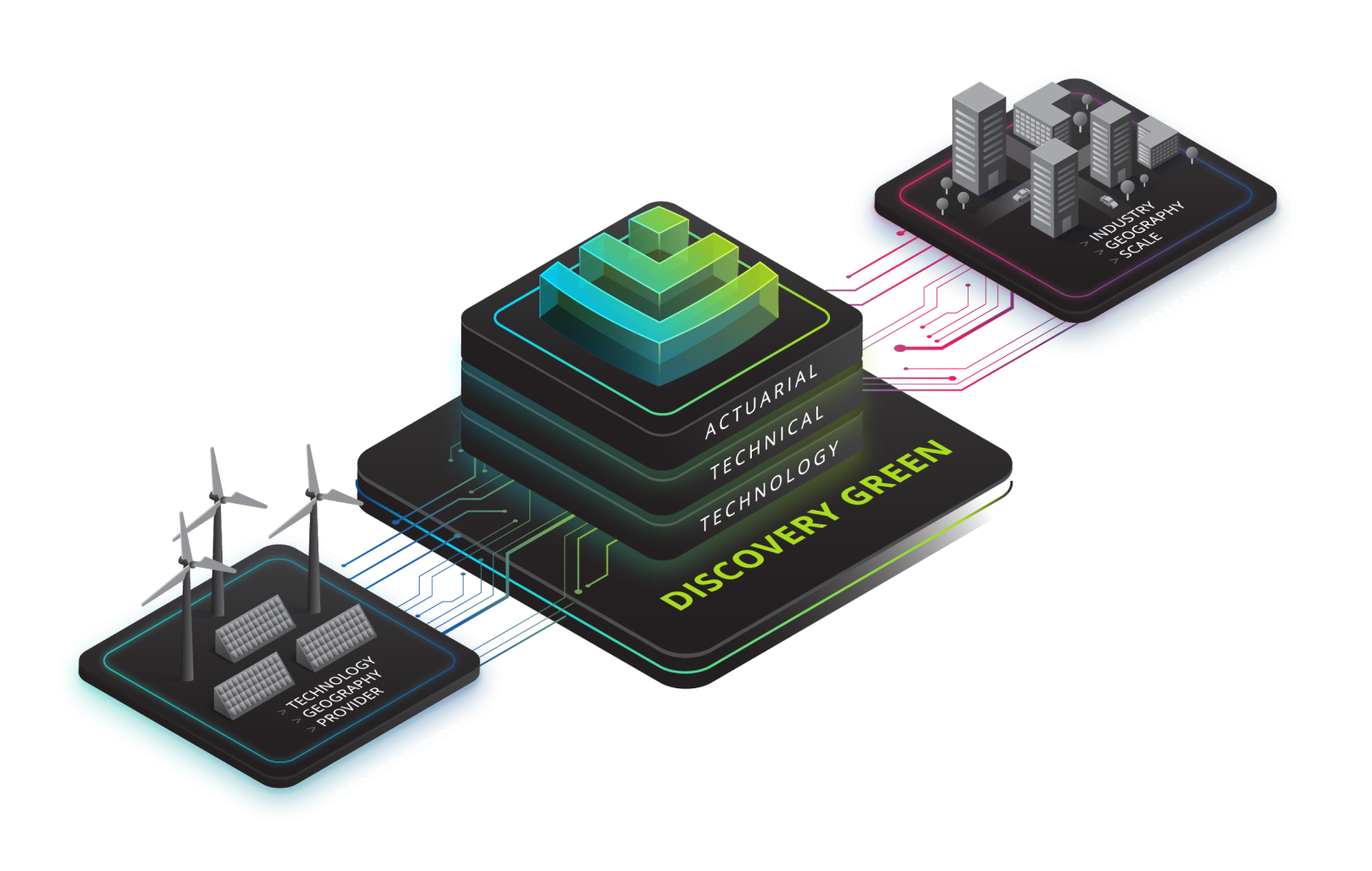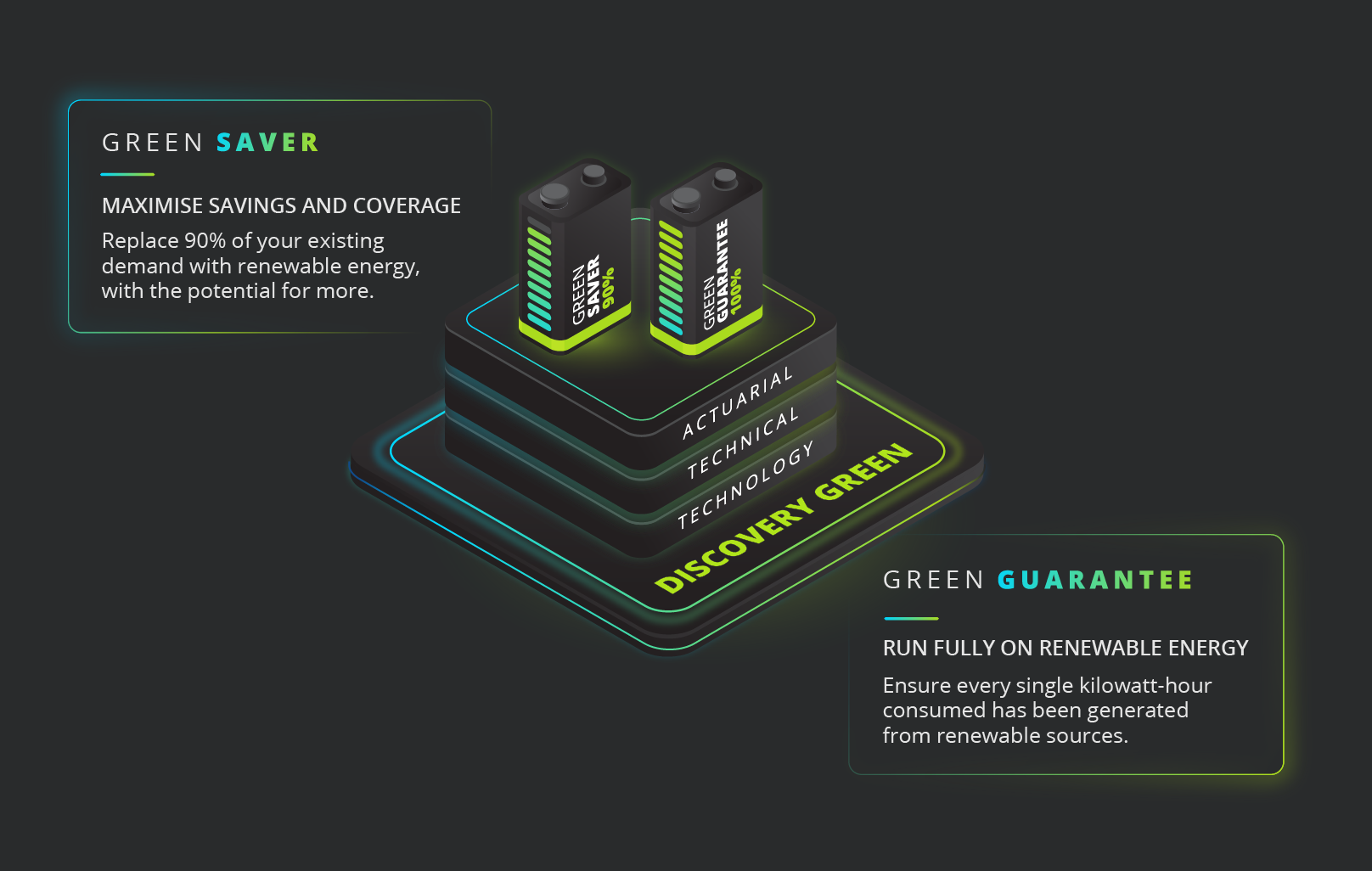Our mission is to establish South Africa as the global leader in renewable energy.
Discovery Green makes it simple and affordable for businesses to run on renewable energy. Our scale, expertise, actuarial modelling, and sophisticated systems help your business meet decarbonisation goals with savings and certainty to the cost of electricity.
Affordable
Up to 20% savings in the first year
Renewable
90% of your consumption certified green
Price certain
Price increases capped at CPI inflation
Protected
Pay only for what you need with platform reallocation
Seamless onboarding
Quotes within a week
A market-first month-to-month renewable energy product for small energy consumers.
Introducing Ampli Energy, a joint initiative between Discovery Green and Sasol to further unlock access to renewable energy for businesses that need it most - from mid-sized corporates and SMMEs to NGOs, that have historically been excluded from South Africa's energy market due to their size.
Ampli Energy provides businesses with immediate access to renewable energy through wheeling. Ampli Energy pays businesses to switch to renewable energy, depositing monthly cashback directly into business bank accounts. Signing up for an Ampli Energy membership is remarkably simple and businesses can cancel anytime without penalty.
No fees. No risks. No hassles. Just monthly cashback for going green.
Your Power Move starts here.
Reserve your spot in the next tranche of energy and start powering your business differently.

Our approach
Businesses should not have to rely on the timing of natural resources, such as the sun shining or the wind blowing, but should run on renewable energy as and when they need to. The Discovery Green platform is unique. We combine Discovery's actuarial expertise with energy wheeling to unlock the full potential of renewable energy for businesses in South Africa.
Read more
Our products
Our products maximise financial savings and minimise business emissions, taking care of all your business needs in a single, simple transaction. Discovery Green protects your business from the risks traditionally associated with renewable energy procurement.
Read moreFeatured articles and resources
Discovery Green wheels in five new agreements across mining, hospitality and property sectors

Discovery Green concludes five wheeling deals across the resources, property and hospitality sectors
How will carbon taxes affect your business' bottom line?
New research from Discovery Green and EY highlights the impact of rising carbon taxes on the electricity costs of South African businesses.
Discovery Green is collaborating with Independent Power Producers to access energy from among the most efficient renewable energy power plant sites across the country. Power plant construction is a complex process that needs considerable funding. There are no renewable energy power plants currently in operation to which you can connect. Discovery Green has partnered with the industry's leading technical, engineering and legal experts to offer a quick timeline for the supply of renewable energy. Discovery Green aims to start wheeling renewable energy by Q4 2026.
Wheeling of renewable energy is a well-established practice globally, but it is still in its early stages in South Africa. Currently, national regulations allow for the wheeling of energy exclusively to high-voltage Eskom-connected clients and a select number of businesses located within certain municipal networks. Discovery Green will wheel renewable energy to your eligible sites under Eskom's traditional wheeling framework currently in use. There's been a growing need for generation capacity and a rapid adoption of renewable energy. This has led to the imminent release of new power wheeling frameworks to support the established Eskom process that will allow wheeling of renewable energy to almost all electricity consumers in South Africa. Discovery Green will be able to wheel renewable energy to your qualifying municipality-connected sites as soon as these frameworks are implemented.
When you enter into a Renewable Energy Supply Agreement (RESA) with Discovery Green, there are no physical changes to the infrastructure supplying you with power. The same transmission and distribution networks that supply your business with utility-supplied electricity are used to supply you with energy from renewable energy sources. When Eskom implements loadshedding, power supply is interrupted completely, including the transmission of renewable energy.
Although wheeling of energy does not provide complete protection from loadshedding in the short term, generating more energy in the form of renewable energy will provide greater stability to energy generation in South Africa and lower the impact of loadshedding over time.
Your business must have an approved electricity meter. This meter tracks electricity usage regularly to facilitate time-of-use billing. Discovery Green integrates with these meters to retrieve details of your electricity use.
Time-of-use is a classification to account for the hour of the day, the day of the month and the season when a kilowatt-hour of electricity is produced and used. A 24-hour period is divided into three time-of-use periods: peak, standard and off-peak.
Peak periods refer to hours of the day when the demand on the national grid is at its highest, usually in the morning and evening. Eskom charges higher tariffs during peak hours to encourage lower use. Time-of-use tariffs are higher during the winter months of June, July and August compared to the remaining months of the year.
To have a kilowatt-hour of electricity you've used successfully credited against a kilowatt-hour of electricity produced, both must be produced and used in the same time-of-use period in a calendar month. For example, a kilowatt-hour of electricity supplied by Eskom that is used during peak times in January can only be offset with a kilowatt-hour of renewable electricity if the renewable electricity is produced during peak times in January. This means a kilowatt-hour of renewable electricity produced during off-peak times cannot be credited against a kilowatt-hour of electricity consumed during peak times, or against a kilowatt-hour consumed during off-peak times in another month.
Time-of-use tracking enables Discovery Green to accurately measure and then reconcile the renewable electricity produced to what is consumed, which results in savings for your business. This saving shows differently depending on the wheeling framework that is in place where your business operates. Under traditional wheeling of power, the saving reflects as a credit on your Eskom bill.
Solar energy will replace your consumption of utility-supplied energy during the day, leaving you with a consumption profile that is weighted towards nighttime consumption. In cases where your business's consumption profile has not been materially skewed by the solar installation, Discovery Green will cover the balance of your energy requirements and replace it with renewable energy through wheeling. For the average business, it is expensive to have on-site solar energy to make a material difference to your energy use. You can continue to draw energy from your solar solution. However, Discovery Green will only replace the utility-supplied electricity you use.
Yes, there are several risks that businesses often don't consider when procuring solar energy.
The remaining nighttime-heavy consumption profile that businesses are left with after procuring solar energy is extremely expensive to cover with renewable energy, requiring either wind energy or battery storage. This leaves businesses reliant on expensive utility-supplied electricity to meet demand during these times. For this reason, businesses face the risk of never being able to replace their remaining consumption with renewable energy at all. It is important that businesses understand the risks of procuring renewable energy in a multi-phased approach, especially when procuring solar energy first.
As more solar power is installed across the country over time, it is expected that the daytime price of utility-supplied electricity will fall due to the excess electricity supplied during this time. In Australia, for example, daytime electricity prices are sometimes negative due to the large amounts of solar energy being produced. Businesses who have entered into long-term solar procurement contracts with fixed prices may find themselves paying more for solar energy than they would be paying for utility-supplied electricity.
Wheeling of renewable energy will reduce your business' scope 2 emissions. For most non-industrial businesses, scope 2 emissions account for most greenhouse gas emissions. Wheeling of renewable energy is often the most effective way to achieve carbon neutrality.
An organisation's greenhouse gas emissions can be divided into three categories: scope 1, scope 2 and scope 3 emissions.
Scope 1 emissions occur because of activities that are directly under the organisation's control. For example, fuel burned by company-owned vehicles.Scope 2 emissions occur from the direct production of energy that is used by the organisation. Scope 2 emissions are generated off-site but are a result of the organisation's energy use, for example, heating and cooling. Typically, scope 2 emissions of a non-industrial company account for 80% of its total greenhouse gas emissions. Scope 2 emissions are reduced through wheeling of renewable energy.
Scope 3 emissions include all other indirect greenhouse gas emissions and occur through an organisation's activities that are not included in scope 1 or scope 2. These emissions are often the most challenging to measure. It includes the entire value chain of the organisation, including suppliers, customers and other stakeholders. For example, employee commutes.
There is a financial benefit to maximising your coverage of renewable energy now as opposed to filling up your demand in incremental steps. Delays in maximising your renewable energy coverage means your business will do without the potential savings available from wheeling. To ever make these lost savings back, the price of renewable energy must fall significantly in future. Over recent years, however, South Africa has experienced a levelling out of both solar and wind prices.
There are also a limited number of power plant sites available with the ability to connect to the national grid. The unpredictability of future grid availability, which is an issue that is faced by countries across the world, may lead to uncertainty in future renewable energy prices and availability.
With renewable energy through Discovery Green, the saving and pricing structure provides certainty of cost and supply.